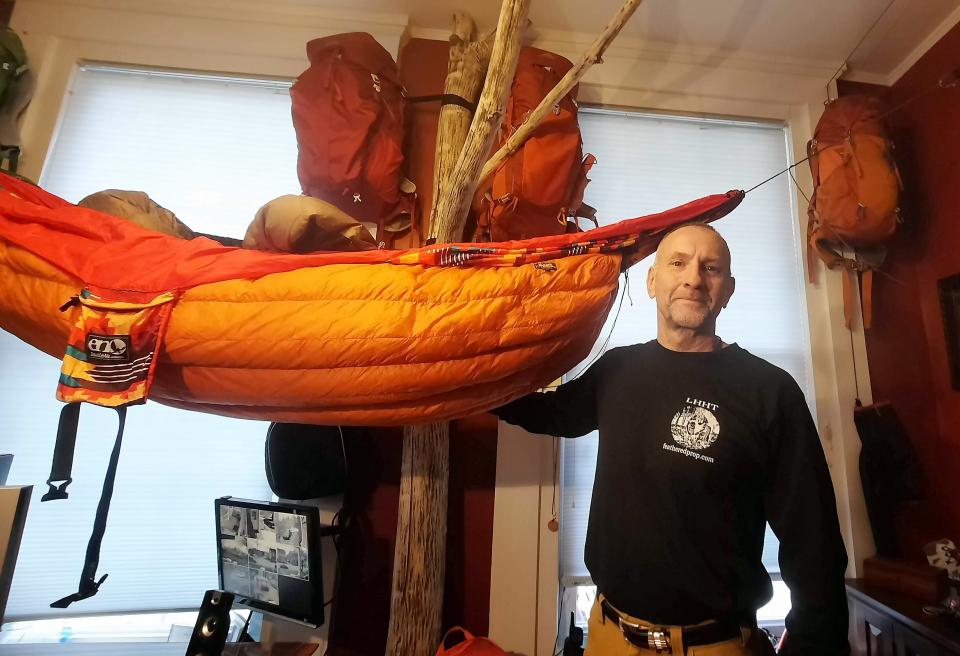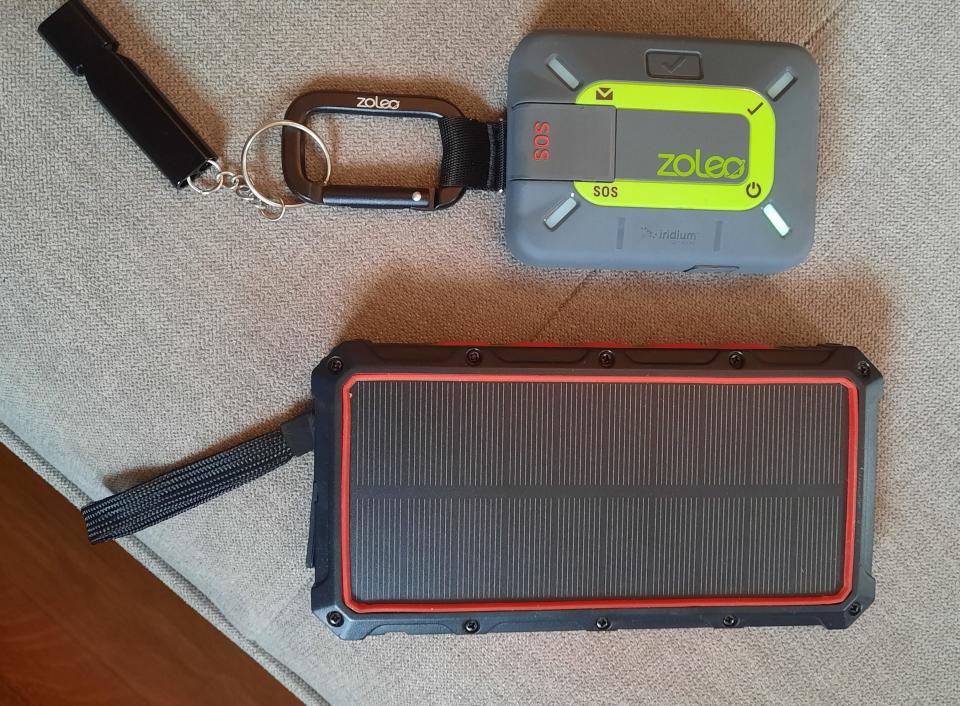How does a Pennsylvania hiker find 'wonder' in cold weather camping?
Dane Cramer has been backpacking for decades in many states and climates, but one of his favorite trips is camping in Pennsylvania in the winter.
“One of the greatest feelings is laying in your hammock at night, and the snow is softly falling, and there’s the stillness of the forest, the crispness of the air,” said Cramer, 60, of Somerset County.
He sees fewer people on the trails during the cold weather months, but he sees some extraordinary nature.
"The challenge of it is just fun," he said.
It’s a challenge to stay warm, and he likes the quiet peace that comes from being alone in the wilderness when there’s snow on the ground.
"It’s kind of like you’re in a bubble in a snow globe, and you’re watching everything around you and being able to observe and be in it. Waking up seeing a fiery red sunrise come up on a crisp, cold morning, you can’t beat that. It’s just wonderful,” he said.
There's something "alluring" about the cold weather.
“I like the cold. I don’t like being cold, but I like the cold if that makes sense," he said. "There’s a challenge to it.”
How do you camp comfortably in winter?
Cramer camps closer to home in winter. He lives in Somerset, so he picks a spot in southwestern Pennsylvania that's comfortable to him: the Laurel Highlands, 3,000 acres of mountainous terrain best known for Ohiopyle State Park's water sports but also active for winter adventurers too.
“The misunderstanding of winter camping is that you are going to freeze. If you have the right gear and know how to use it, you’re going to be good," he said.
Instead of sleeping on the ground in a tent, he uses a quilted hammock and an overhead nylon tarp for shelter.
“I moved to hammocks about six years ago,” he said, rather than using a traditional tent. When staying at shelters in the woods, he said it was common to encounter mice. The challenge with a hammock is finding two trees relatively close together and learning the proper placement to get “the hang” right for your stay.
“There’s a little more tweaking involved,” he said. However when you have it figured out, a quilted hammock is more comfortable than a tent, he said. He discovered he gets a better night’s rest in a hammock versus sleeping on the ground in a tent where he had to deal with rocks, roots and small vermin looking for his food.
“You can wrap yourself up in it,” he said about staying warm and listening to the sounds of the forest.

An experienced hiker, he has crossed sections of the Appalachian Trail and backpacked through parts of Massachusetts, Connecticut, Maryland, West Virginia and Virginia. His biggest hike was in scenery-rich Montana.
“It was mind-blowing, fantastic. The changing scenery of Montana was amazing. I needed to get out of the Appalachians just to see what it’s like,” he said.
He likes to be in the woods throughout the year, but prefers spring, fall and winter.
In addition to the physical benefits that come from hiking in the winter, he said there are mental benefits as well.
“It’s relaxing. I can’t even begin to describe the wonder of it all. Laying there in your hammock on a moonlit night when there’s snow on the ground and the forest is lit up. It’s just so cool,” he said.
Who knew?:What does outdoor recreation do for Pennsylvania's economy? $14 billion
Everyone's welcome:Deer camp owner in Pocono Mountains introduces people to the outdoors
What it takes to ski:PA ski resorts bypass Mother Nature. 'We rely about 95% on manmade snow.'
Food for camping
Here are some tips about food and water:
High calories: If you are hiking or snowshoeing during the winter on an extended trip, pack high calorie foods to trudge through the white powder. “Snowshoeing is an incredible workout,” Cramer said.
Water: Cramer camps where there is a water source but occasionally he has melted snow to use for cooking.
Breakfast: He usually eats one-minute oatmeal for breakfast, and he has found ways to make foods in freezer bags with hot water. He puts his oatmeal in a freezer bag, pours boiling water into it, zips it up then keeps it on hold in an insulated cup for five minutes. He also recommends cold cereal with powdered milk and warm water.
Snacks: Clif bars, but keep in mind they become hard in cold weather.
Lunch: He suggests packets of tuna, or anything that doesn’t freeze. He said tuna with oil provides extra calories over tuna packed in water. He also likes to to dehydrate some food to take along that can be prepared with hot water from his small camp stove. “I dehydrate my own chili,” he said, and he eats it with a bagel. (There are instant meals available in stores, but he points out some are high in sodium.)
Pandemic camping:Campgrounds flourishing as more embrace the outdoors
Benefits of a tent:Pennsylvania camping season has arrived: Try a tent for mobility and memories
What to wear and how to hike in the cold

Hiking in the cold is a different beast, so these are some suggestions on making it comfortable:
Walking to camp: Hike at a slower pace to reduce the amount of sweat produced. It will keep clothes drier.
Plan the route: It will be harder to hike in the snow, so plan fewer miles than a warm weather trip would entail.
On your feet: In the summer months, people pack camp shoes - like Crocs - to wear at a campsite for a break from the hiking boots. In winter, hiking boots are all that's needed. “If you get them wet, you have to make a fire to dry them out. That’s the risk you take," he said. He wears gaiters that reach over his shin area to keep the snow off his pant legs.
Clothing: Cramer packs a change of clothes for every day of the trip to make sure he's starting each day with dry clothes. Wicking materials that dry fast are much better than cotton. “I layer in the winter so I can talk stuff off as I get warm," he said.
Take a friend: While Cramer enjoys the solitude of hiking alone, he recommends hikers take someone with them on their first adventures. He also suggests testing new gear by camping in the backyard before trying to stay in a remote area.
Staying connected: Cell phone service isn't always available in the wilderness. Cramer has a small satellite communicator that clips on his coat. It has a “check in” button to send a text message to pre-set contacts. It also has an SOS alert feature. There’s also an app that syncs a phone to the device to send and receive messages via satellite. The service requires a subscription. If he’s going on an extended day trip, he takes a rechargeable battery bank that’s about the size of a phone to recharge his phone.
Solar power for campers:Pa. Campers look to solar panels for remote power needs of motorhomes
Follow his adventures
On one of his early hiking adventures he started journaling about what he saw and felt. He has been doing that ever since with first person stories and videos online.
Follow his adventures by visiting his website featheredprop.com and similarly named Youtube channel @Featheredprop.
Being a history buff, the name feathered prop comes from a World War II aviation term. When a plane had engine trouble or battle damage, the pilot would feather the prop into the wind to reduce the chances of it spinning.
“In a way we’ve all taken on battle damage, and life just throws things at you. We all learn to kind of feather that prop a little bit and keep moving, at least that’s what we should do. So for me, feathered prop is just a way of describing the human experience with a faith in God," he said.
Women in the outdoors:'We have more fun than anyone.' Sisters on the Fly teaches women skills in Pa., nationwide
Where to winter camp in Pennsylvania
If you don’t have access to private land, there are many options across the state to camp this winter. The Pennsylvania Department of Conservation and Natural Resources manages state parks and state forests.
In western Pennsylvania, visit Laurel Ridge State Park, Moraine State Park, Ohiopyle State Park, Oil Creek State Park , Raccoon Creek State Park, and Ryerson Station State Park. In the north, Ole Bull State Park takes reservations. In southern Pennsylvania, Penn-Roosevelt State Park is open. In the eastern part of the state, check out French Creek State Park, Promised Land State Park, Ricketts Glen State Park, and Salt Springs State Park.
The DCNR’s website, dcnr.pa.gov, offers advice on how to camp including the following:
There is no fee for a state forest primitive camping permit. Primitive campers spending no more than one night at a campsite do not need a camping permit; however, a free camping permit is required if:
You desire an emergency point-of-contact.
You stay at a campsite more than one night.
You stay at a campsite designated “permit required.”
A campfire is desired during spring wildfire season -- you must obtain permission from the state forest to have a campfire from March 1 through May 25; no campfires are permitted when the state forest district forester determines the forest fire danger to be high, very high, or extreme.
You camp using a vehicle for storage or transportation.
You camp within the Pine Creek Gorge along the Pine Creek Rail Trail in Tiadaghton or Tioga State Forests.
To request a free, state forest primitive camping permit, please contact the state forest district office for where you are planning to camp.
Primitive camping in state parks
Hiking in and putting up a tent where you choose is not permitted in Pennsylvania state parks. All camping must be in a designated camping area and on designated sites. Many Pennsylvania state park campgrounds have walk-in sites which are for tents only and are more private than campsites with a paved camping pad.
Some parks have backpacking trailside shelters or sites, which can be in very remote areas, but visitors still must camp in designated areas.
There are five state parks that allow backpacking and overnight hikes: Laurel Ridge, Ohiopyle, Moraine, Oil Creek and Raccoon Creek.
These parks provide backpacking trails with overnight trailside shelters or sites. You must pre-register to hike and camp overnight at these state parks.
More:Night skies in Pennsylvania: State parks offer clear views for stargazers, astrotourists
Primitive camping guidelines in state forests
Backpack campers are permitted to camp in most areas of the forest without a permit if staying no more than one night in any location. Backpackers may camp overnight anywhere except in designated "natural areas;" within 200 feet of a forest road, within 25 feet of a trail, and within 100 feet of a stream or any open water. Trailside camping (backpacking) is a popular form of primitive camping and is often done along one of the 18 State Forest Hiking Trails. The DCNR reports other local trails can also be used to form unique and adventurous routes.
Brian Whipkey is the outdoors columnist for USA TODAY Network sites in Pennsylvania. Contact him at bwhipkey@gannett.com and sign up for our weekly Go Outdoors PA newsletter email on your website's homepage under your login name. Follow him on Facebook @whipkeyoutdoors.
This article originally appeared on Erie Times-News: Camping in the winter in state parks and state forests in Pennsylvania

